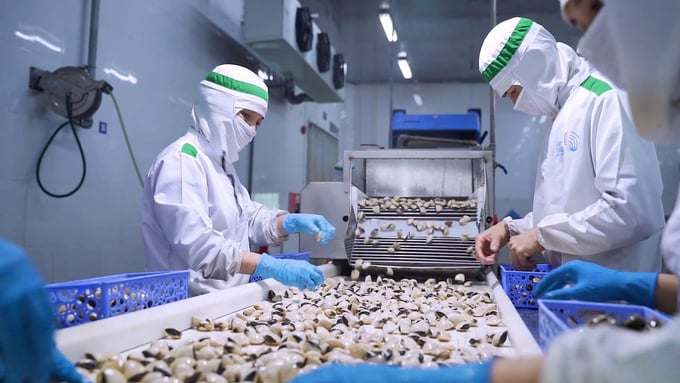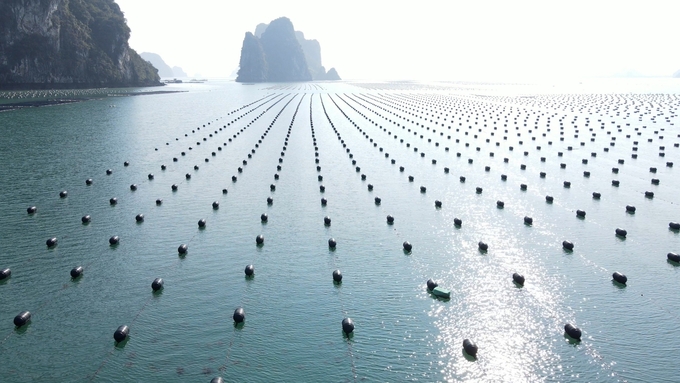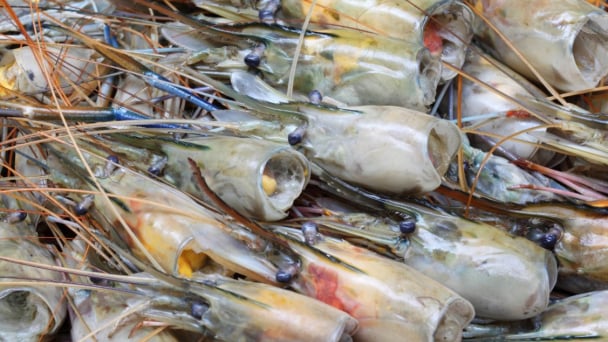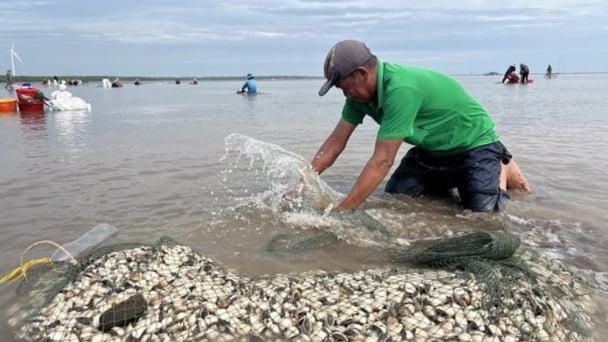May 31, 2025 | 04:15 GMT +7
May 31, 2025 | 04:15 GMT +7
Hotline: 0913.378.918
May 31, 2025 | 04:15 GMT +7
Hotline: 0913.378.918

Deputy Minister of Agriculture and Rural Development Phung Duc Tien believes that mollusks and seaweed are two sectors with great potential for development in the coming time. Photo: Hong Tham.
Mr. Nguyen Van Huu, Deputy Head of the Aquaculture Department at the Directorate of Fisheries (Ministry of Agriculture and Rural Development), shared that in 2024, the total area for mollusk farming across the country is 57.000 hectares, with a production output of 477.878 tons, reflecting an 8.4% increase compared to the same period last year.
The main mollusk species currently being farmed include: clams, blood clams, Manila clams, green mussels, sweet snails, blood cockles, oysters, scallops, sea cucumbers, Pacific oysters and jumping snails.
Vietnam has been exporting mollusks to various international markets. In the first 11 months of 2024, the export turnover for this product reached 195.3 million USD, which is a 67% increase compared to the same period last year. The main exported mollusk species include clams, oysters, scallops, and mussels.
Regarding seaweed, various studies indicate that the potential area for seaweed cultivation in Vietnam is approximately 900.000 hectares (equivalent to an annual production of 600.000-700.000 tons of dry seaweed). However, seaweed farming in Vietnam remains limited to a small scale. Over the years, there has been no significant breakthrough in expanding the seaweed cultivation area. Between 2005 and 2024, the seaweed farming area has only increased from 8.265 hectares to 16.500 hectares. The estimated harvest for 2024 is around 155.000 tons of fresh seaweed.
Ms. Le Hang, Director of Communications at the Vietnam Association of Seafood Exporters and Producers (VASEP), shared that the seaweed market is expected to grow by 5.56 billion USD, with an estimated compound annual growth rate (CAGR) of 7.22% from 2023 to 2028.
The growth of the market is driven by several factors, including the increasing demand for seaweed-flavored food and beverages as well as the growing consumer awareness of health and wellness.
"However, despite this positive outlook for the market, Vietnam's seaweed export turnover in 2023 reached only 5.563 million USD, which remains relatively modest and not yet stable. The key export markets for Vietnamese seaweed include Canada, Indonesia, Taiwan, Japan and other countries", Ms. Hang added.
Ms. Nguyen Thi Sam, Director of Japi Foods Co., Ltd., stated that it is necessary to establish a seaweed value chain, from seedling production, farming, processing, to export.
According to Mr. Tran Anh Dung, Permanent Vice Chairman of the Nam Định Provincial People's Committee, in recent years, clam farming in Nam Định has primarily focused on the Ben Tre white clam species. This industry has received significant attention and development, becoming one of the main pillars of the province's marine economic growth. The clam farming sector is concentrated in two main commercial farming zones located in Giao Thuy and Nghia Hung districts, which together cover a total area of approximately 2.200 hectares. In 2024, the estimated clam farming production in Nam Dinh is projected to reach around 49.500 tons, which will account for approximately 69% of the province's total brackish and saline aquaculture output.
In terms of seaweed production, Nam Dinh currently sees it primarily as a secondary product of aquaculture, with an annual output of over 4.000 tons of fresh seaweed. The majority of this seaweed is golden thread algae, which is collected by aquaculture farmers from various sources such as canals, water storage ponds, and shrimp farming ponds.
"At present, the mollusk and seaweed farming sectors in Nam Dinh are still facing numerous challenges. There is a strong need for focused attention, particularly from the central ministries and government agencies, to help reorganize production processes, invest in infrastructure, and support research aimed at improving seedling quality. This would significantly contribute to the sustainable development of the mollusk and seaweed farming industries. The ultimate goal is to continuously increase product value, broaden consumer markets and especially expand the export market", Mr. Dung emphasized.

The clam industry must meet market demands, which include: large-sized clams, good quality, low cost, competitive pricing, food safety and environmental friendliness. Photo: Hong Tham.
Mr. Nguyen Ho Nguyen, CEO of Lenger Seafood Vietnam Co., Ltd., shared, "Vietnam has great potential to develop the clam farming industry, improving the lives of millions of farmers, but the industry must meet market demands, which include: large-sized clams, good quality, low production costs, competitive prices, food safety and environmental friendliness".
Regarding seaweed, Mr. Dinh Xuan Lap, Deputy Director of the International Cooperation Center for Sustainable Aquaculture and Fisheries (ICAFIS) under the Vietnam Fisheries Association, emphasized that there are three issues that need immediate attention.
Firstly, although there are some good seaweed varieties available, it is necessary to ensure that they are affordable for farmers. Secondly, seaweed such as golden thread algae, if dried under direct sunlight as it currently is, does not meet quality standards and long-term solutions must be explored. Thirdly, it is important to focus on increasing the value of seaweed by promoting deep processing into high-value products such as food extracts, pharmaceuticals and biodegradable plastics, which would help raise the value of seaweed.
Deputy Minister of Agriculture and Rural Development Phung Duc Tien affirmed that while the fisheries sector faces many challenges in 2024, it has achieved significant accomplishments: production reached 9.6 million tons and export turnover exceeded 10 billion USD. Specifically, mollusk farming reached nearly 480.000 tons, while seaweed production surpassed 150.000 tons.

The seaweed farming model combined with oyster farming in Quảng Ninh. Photo: Hong Tham.
Deputy Minister Phung Duc Tien emphasized that, in addition to contributing to economic growth, creating job opportunities, and providing livelihoods for coastal fishermen, mollusk farming and seaweed cultivation also play an essential role in alleviating the pressure on the exploitation of aquatic resources. These activities help restore fishery stocks and reduce conflicts related to the protection of marine resources. Furthermore, they contribute significantly to the realization of Vietnam's national fisheries development strategy. The Deputy Minister remarked: "Promoting the development of mollusks and seaweed is in line with the current global trend of sustainability and green growth".
For this reason, in the near future, the Directorate of Fisheries, in addition to working on policy development and institutional mechanisms, must strengthen collaboration among relevant stakeholders such as government regulatory bodies, research institutes, universities, businesses and farmers. The Department of Quality, Processing and Market Development should enhance efforts in trade promotion and seek to expand export markets. Research institutions and universities need to prioritize scientific research and technological advancements to better align with practical, real-world demands. Meanwhile, businesses should innovate and update technologies, improve management practices and continuously gather market information to stay competitive. Local authorities must implement effective regional and provincial planning related to fisheries.
Furthermore, it is crucial to continue addressing the issue of high-quality seedlings, improve veterinary care, ensure disease prevention and focus on biosecurity measures. Expanding international cooperation, researching new and more efficient farming methods are also critical steps to support the growth of these industries.
Deputy Minister of Agriculture and Rural Development Phung Duc Tien emphasized that both mollusk farming and seaweed cultivation hold vast potential for future growth. These sectors have already established pathways to international markets. These fields are also supported by a comprehensive ecosystem, which includes state management agencies, scientific research and technology, businesses and farmers. Despite these advantages, Deputy Minister Tien noted that the collaboration among these stakeholders is still not as strong and integrated as it should be.
Translated by Phuong Linh

(VAN) Seafood by-products are opening a new path, combining green growth and technological innovation to enhance the industry's value.

(VAN) Mr. Nguyen Thanh Cong, Vice Chairman of the Son La Provincial People's Committee, reflects on Son La’s journey from barren hills to fruitful orchards after a decade of hard work.

(VAN) FAO’s Director-General addresses the 5th Baghdad International Water Conference.
/2025/05/26/1716-4-nongnghiep-191706.jpg)
(VAN) Chain linkages, technological innovation, and raw material zoning are three strategic pillars for the coconut industry to strongly develop and elevate its position on the global agricultural map.
![Advanced mariculture – an inevitable trend: [4] Accompanied by scientists](https://t.ex-cdn.com/nongnghiepmoitruong.vn/608w/files/sohk/2025/05/13/1941-pgsts-vo-van-nha-140958_717.jpg)
(VAN) According to Assoc. Prof. Dr. Vo Van Nha, Director of the RIA III, the development of advanced offshore mariculture is no longer an option but an essential path for Vietnam’s fisheries sector.

(VAN) Vietnam is intensifying the development of mollusk farming areas that meet international standards, aiming for sustainable growth and enhancing its export position in the global seafood market.
![Advanced mariculture – an inevitable trend: [3] Policy-driven momentum](https://t.ex-cdn.com/nongnghiepmoitruong.vn/608w/files/doanhtq/2025/05/21/0104-0616-0348-nuoi-bien-170339_789.jpg)
(VAN) To ensure the success of offshore mariculture that uses advanced technologies, it is essential to establish supportive policies that inspire both individuals and enterprises to invest with confidence.